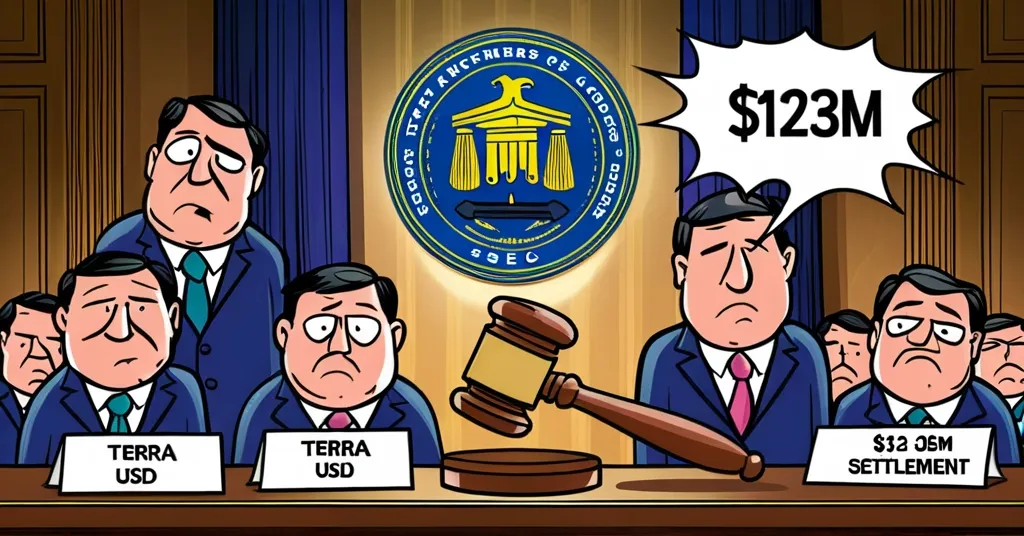SEC Charges Tai Mo Shan with Misleading Terra USD Investors; Settles for $123 Million

SEC Accuses Tai Mo Shan of Misleading Terra Investors
The U.S. Securities and Exchange Commission (SEC) has charged Tai Mo Shan Limited, a branch of Jump Crypto Holdings LLC, with deceptive practices concerning Terra USD, a stablecoin designed to maintain a consistent value of $1. Yet, this claim of stability was anything but stable.
- SEC accuses Tai Mo Shan Limited of misleading investors about Terra USD’s stability.
- Terra USD lost its critical $1 peg in May 2021, revealing dependencies on external help.
- Tai Mo Shan allegedly involved in selling unregistered LUNA tokens, classified by the SEC as securities.
- The company has agreed to a $123 million settlement without any admission of guilt.
- The SEC is tightening its regulatory efforts, even as SEC Chair Gary Gensler prepares to step down.
The SEC’s Allegations
The SEC’s case revolves around allegations that Tai Mo Shan Limited misled investors by suggesting Terra USD’s stability was solely reliant on an algorithm. In reality, when Terra USD lost its $1 peg, it became clear that external help was essential to maintain its value. This situation exposed the vulnerability of stablecoins, which promise reliability but can falter due to unforeseen dependencies.
Beyond the misleading stability claims, Tai Mo Shan is accused of selling LUNA tokens without proper registration, a move seen as selling unregistered securities. The SEC, which holds a zero-tolerance policy for such infractions, classifies LUNA tokens as securities, making these sales a significant breach of regulatory compliance. In response, Tai Mo Shan agreed to pay over $123 million in fines, although they have not admitted to any wrongdoing. As one observer noted, “The SEC calls this misleading. Hard to argue with that.” Another pointed out, “They’re not exactly waving a white flag, just agreeing to move on.”
Implications for the Crypto Market
This scenario underscores the fragility within the cryptocurrency ecosystem and highlights the crucial role of regulatory oversight. The incident with Terra USD serves as a stark reminder of the risks investors face when promises of stability fall short. The SEC’s actions are a part of a broader strategy to enforce transparency and protect investors from misleading claims and unregistered sales.
The stability of stablecoins – digital currencies pegged to a stable asset like the U.S. dollar – is critical in the volatile cryptocurrency market. The fall of Terra USD also raises questions about the reliability of similar digital assets and the necessity for stronger regulatory frameworks to protect investors.
Future Regulatory Landscape
The departure of Gary Gensler, SEC Chair, adds another layer of complexity to the crypto regulatory landscape. Gensler has been a staunch advocate for rigorous enforcement in the crypto market, emphasizing the protection of investors and the need for greater transparency. His exit could signal shifts in SEC strategies, yet the commitment to clamping down on non-compliance remains strong.
Looking ahead, regulatory bodies might intensify their scrutiny of misrepresentations in the crypto space. Stablecoin projects will need to ensure transparency and build investor trust by clarifying their operational mechanics. This will likely involve more rigorous disclosure requirements and compliance checks.
Key Takeaways and Questions for Consideration:
- What steps can investors take to safeguard themselves from misleading claims in the crypto market?
- How might upcoming changes in SEC leadership affect regulatory approaches to cryptocurrencies?
- What measures can stablecoin projects implement to ensure transparency and maintain investor confidence?
As the crypto market matures, participants must remain vigilant and informed. The lessons from the Terra USD debacle stress the importance of understanding the true nature of digital assets, encouraging both investors and developers to foster a more resilient and reliable market.



